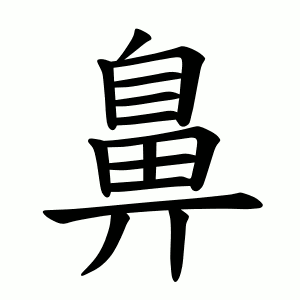鼻
- nose;
- nasal;
- rhino-;
Etymology
It is a phono-semantic compound character composed of:
自 (ja, “self”), originally a pictograph of a nose, and
畀 (bi, meaning “to give”), used for its phonetic value.
Originally, the character 自 itself meant “nose”, but over time it came to mean “oneself” or “self”.
As a result, 鼻 was created to preserve the meaning “nose.”
Usage in Korean
When used as a radical, 鼻 conveys meanings related to the nose or breathing.
Examples include:
齈 (콧물 농, nasal mucus)
鼾 (코고는소리 한, snoring)
鼽 (코막힐 구, nasal congestion)
齉 (코막힐 낭, stuffy nose)
Among these, only 鼻 itself is commonly used in everyday life.
Characters with 鼻
鼻
코
비
ko
bi
Kangxi radical:209
Strokes:14
Unicode:U+9F3B
Cangjie input:
- 竹山田一中 (HUWML)
Composition:
- ⿱ 自 畀
- ⿱ 自 𢌿
